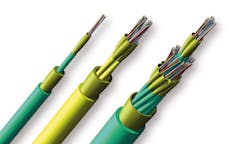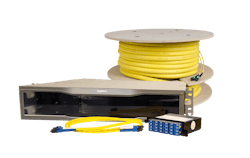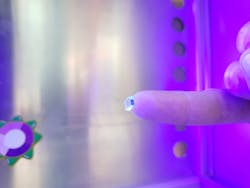Anything but basic: Cabling media shines a light on innovation
The 2020 Cabling Innovators Awards includes six honorees in the category of cabling media. Proving that research, development, and innovation are alive and well in the realm of new-product development, these honorees are paving the way for future applications.
The MIC 250 2.0 cable from Corning is optimized for splicing and utilization with pigtail cassettes. The cable’s design uses subunits made up of 12x250-µm colored fibers. This design helps address challenges arising from the neverending need for increasing bandwidth, specifically including the growing popularity of pigtail splicing with cassettes. “Although tight-buffered cables can be fusion spliced to other tight-buffered cables as well as loose-tube cables, splicing tight-buffered fiber to loose-tube fiber is inefficient,” Corning explains. “Fusion splicing tight-buffered cables into cassettes using 250-µm fibers requires arduous processes.” Historically, an indoor loose-tube fiber cable optimized for fusion splicing with cassettes has not been widely available. Corning gathered installer feedback on the use of splice cassette installation with tight-buffered cabling solutions, and used that feedback to drive the creation of MIC 250 2.0, a splice-optimized indoor plenum loose-tube cabling solution.
Legrand’s Infinium Quantum end-to-end fiber system provides a 0.75-dB channel link loss—a 67% improvement over standard systems and a 55% improvement over other ultra-low-loss optical fiber systems available. Available in both singlemode and multimode, Infinium Quantum was exclusively designed to allow a fast, reliable migration path to 400G and beyond by reducing or eliminating the need to replace cabling components. In addition to its low total loss (0.75dB total channel connection loss for both SM and MM; 49dB total channel connection return loss for SM; 34dB total channel connection return loss for MM), the system reduces the need for fusion splicing to obtain low link loss and maintains the ability to add crossconnections, signal drops, splitting, or switching components into the link.
Circuit integrity cables, required by code to ensure survivability of critical circuits in order to protect people and property in the event of a fire, have been available for nearly 20 years. But their design has not significantly changed in that time. Many fire-alarm and area-of-refuge systems require multipair cable constructions, but most traditional pathway survivability cable options have been limited to one-pair constructions. The DuraLIfe II multi-conductor Fire Rated Cable from Radix Wire & Cable changes the way circuit integrity cables are installed. “No more messing around with multiple one-pair cables,” Radix explains. “DuraLife multi-conductor can provide up to four pairs under one jacket. In free-air installations, DuraLife multi-conductor will provide a more orderly appearance and reduce labor time. For in-conduit systems, the cable not only allows for smaller conduits, but also more conductors within the conduit, thus providing economical savings and ease of installation.” The DuraLife II Multi-Conductor Fire Rated Cable is available in 18-AWG through 12-AWG in both shielded and non-shielded constructions.
Rosenberger OSI’s PreCONNECT SEDECIM is a parallel-optic system optimized for 400GBase-SR8. It uses the MTP/MPO16 connector system, which is the MDI of 400GBase-SR8 transceivers. The connector enables data transfer of 400 Gbits/sec via 8 parallel full-duplex transmission lanes of 50 Gbits/sec each with PAM4 coding (8x50G) over a range of up to 100 meters. One of PreCONNECT SEDECIM’s innovations is that the ferrule endfaces of the MTP/MPO 16-fiber multimode connector are 8-degree APC angularly polished. This angled polish enables the return loss to be significantly improved, to a minimum of 50 dB. “The APC 8-degree angled polish has so far only been used from the outset for singlemode MTP/MPO ferrule endfaces to achieve reliable return loss,” Rosenberger says. “In contrast to this, only the PC 0-degree straight polish was previously used for multimode MTP/MPO ferrule endfaces. Due to their PC 0-degree straight polish design, multimode MTP/MPO connectors were previously particularly susceptible to performance problems caused by dirt particles, which in the past often led to unreliable too low return-loss values. In recent years, this problem has become increasingly sever due to the sharp rise in application data rates. The introduction of reflection-sensitive PAM4 coding at 400GBase-SR8 and other multimode applications with serial lane speeds of 50 Gbits/sec has shown its full extent.”
Modular Photonics’s OMPlex singlemode emulator family is based on a passive plug-and-play silica photonic chip that solves the modal dispersion problem and enables multimode fiber to perform like singlemode fiber. OMPlex delivers fast data rates over long distances, supporting 1-, 10-, 25-, 40-, and 100-Gbit/sec transmission over 2 kilometers of all multimode fiber types. Modular Photonics explains it developed its products “after extensive consultation and analysis of customer problems, constraints, and market pressures.” The OMPlex family offers the following characteristics: Minimum 100x improvement in maximum data speed over MMF; low insertion loss (<2.5dB back-to-back) to stay within transceiver power budget; low product cost (substantially less than recabling a fiber link); small footprint (compatible with SFP components); quick installation time; a passive solution that avoids cost of additional electronics; transparent to IT protocols (compatible with 1310- and 1550-nm bands as well as wavelength-division multiplexing formats); long-life operation and compliance to non-hazardous material requirements. “The OMPlex upgrade solution for a single duplex fiber link has a typical cost point of $2,000, comprising $1,500 for a pair of the OMPlex duplex devices, $400 for a pair of generic high-speed transceivers, and $100 labor,” explains Modular Photonics. “This cost point is independent of the link length or type of multimode fiber used.”
Radix Wire & Cable collaborated with Champion Fiberglass to develop the first-ever Two Hour Fire Rated 300V CIC (cable in conduit) system approved for installation in phenolic conduit. DuraLife II Two Hour Fire Rated CI/CIC Cable in Phenolic Conduit meets the need for a corrosion-resistant, zero-smoke/zero-halogen conduit option for mechanical protection of two-hour fire-rated 300V fire alarm systems used in emergency circuits for transit applications and other damp locations such as underground facilities. “The Radix engineering team led the way in this product’s development, with their extensive knowledge of high-temperature silicone compounds and previous experience with developing cables to meet the extreme environments of the UL2196 two-hour fire-rated test,” Radix explains. “Internal testing began at the company lab, in order to determine optimum cable fill ratios and narrow down the best conduit options. Preliminary testing results revealed a frontrunner, with Champion’s Flame Shield XW Phenolic, and the two companies proceeded to the full-scale fire rating testing at the UL facility in Northbrook, IL. The cable system, including all components, was subjected to the extreme rigors of the UL2196 test, which includes both horizontal and vertical orientation.” The product gives contractors an attractive option to protect critical circuits in transit and underground applications.






